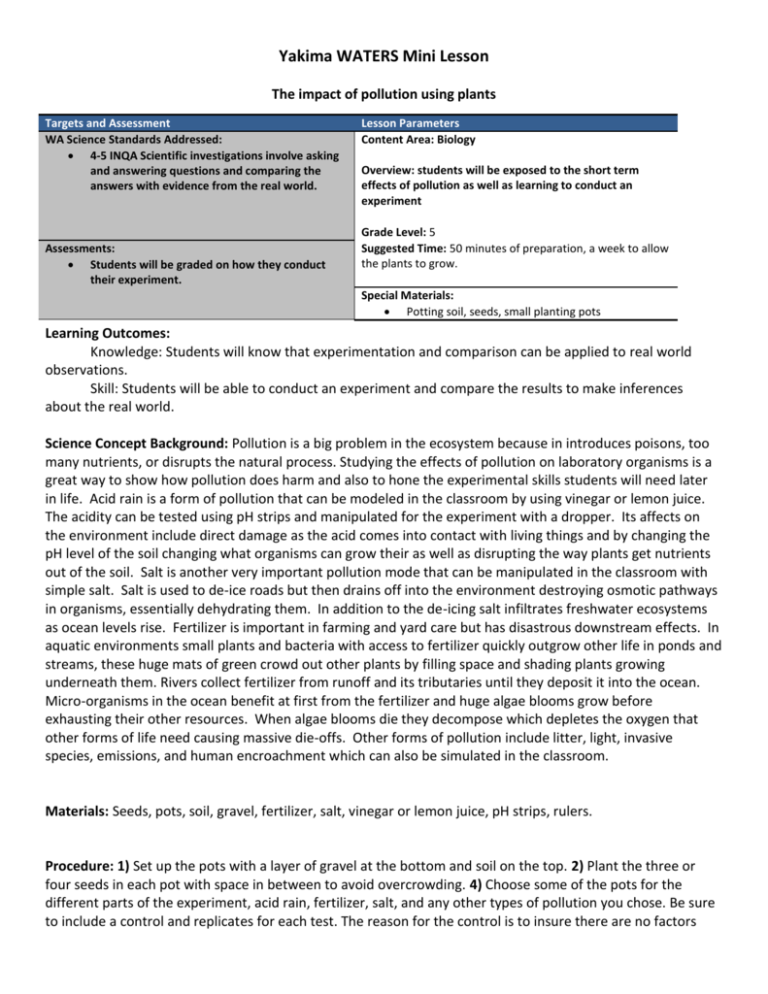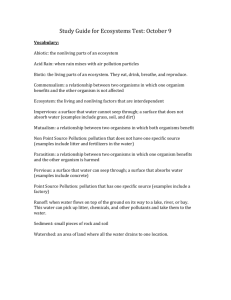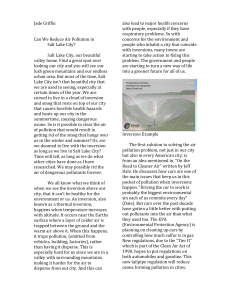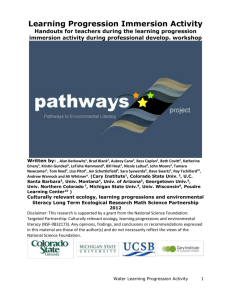WATERS Mini Lesson
advertisement

Yakima WATERS Mini Lesson The impact of pollution using plants Targets and Assessment WA Science Standards Addressed: 4-5 INQA Scientific investigations involve asking and answering questions and comparing the answers with evidence from the real world. Assessments: Students will be graded on how they conduct their experiment. Lesson Parameters Content Area: Biology Overview: students will be exposed to the short term effects of pollution as well as learning to conduct an experiment Grade Level: 5 Suggested Time: 50 minutes of preparation, a week to allow the plants to grow. Special Materials: Potting soil, seeds, small planting pots Learning Outcomes: Knowledge: Students will know that experimentation and comparison can be applied to real world observations. Skill: Students will be able to conduct an experiment and compare the results to make inferences about the real world. Science Concept Background: Pollution is a big problem in the ecosystem because in introduces poisons, too many nutrients, or disrupts the natural process. Studying the effects of pollution on laboratory organisms is a great way to show how pollution does harm and also to hone the experimental skills students will need later in life. Acid rain is a form of pollution that can be modeled in the classroom by using vinegar or lemon juice. The acidity can be tested using pH strips and manipulated for the experiment with a dropper. Its affects on the environment include direct damage as the acid comes into contact with living things and by changing the pH level of the soil changing what organisms can grow their as well as disrupting the way plants get nutrients out of the soil. Salt is another very important pollution mode that can be manipulated in the classroom with simple salt. Salt is used to de-ice roads but then drains off into the environment destroying osmotic pathways in organisms, essentially dehydrating them. In addition to the de-icing salt infiltrates freshwater ecosystems as ocean levels rise. Fertilizer is important in farming and yard care but has disastrous downstream effects. In aquatic environments small plants and bacteria with access to fertilizer quickly outgrow other life in ponds and streams, these huge mats of green crowd out other plants by filling space and shading plants growing underneath them. Rivers collect fertilizer from runoff and its tributaries until they deposit it into the ocean. Micro-organisms in the ocean benefit at first from the fertilizer and huge algae blooms grow before exhausting their other resources. When algae blooms die they decompose which depletes the oxygen that other forms of life need causing massive die-offs. Other forms of pollution include litter, light, invasive species, emissions, and human encroachment which can also be simulated in the classroom. Materials: Seeds, pots, soil, gravel, fertilizer, salt, vinegar or lemon juice, pH strips, rulers. Procedure: 1) Set up the pots with a layer of gravel at the bottom and soil on the top. 2) Plant the three or four seeds in each pot with space in between to avoid overcrowding. 4) Choose some of the pots for the different parts of the experiment, acid rain, fertilizer, salt, and any other types of pollution you chose. Be sure to include a control and replicates for each test. The reason for the control is to insure there are no factors that affect the plants outside of the experimental perimeters. The role of replication is part of the repeated trials in experimentation. 5) Over the next week or so have the students observe and record what they see happening to the plants by observing growth with a ruler. Water when needed. Key questions: Have the students make predictions based on they know about pollution about how their plants will grow. Ask why the control and replicates are important. Ask how different pollutants would impact the environment. Extension(s): Graph the growth of the plants with graph paper with time or treatments in different configurations. Have the students practice graphing and determine the best way to present their data. Teaching Tips: Put the plants in a safe place while the students are not observing them for their experiments. Supplements: http://www.howtodothings.com/education/how-to-grow-plants-in-the-classroom http://www.proteacher.org/a/14903_Pollutants_%26_Plants.html Author: Dale Jansons, Yakima WATERS Project, CWU, Winter 2011











